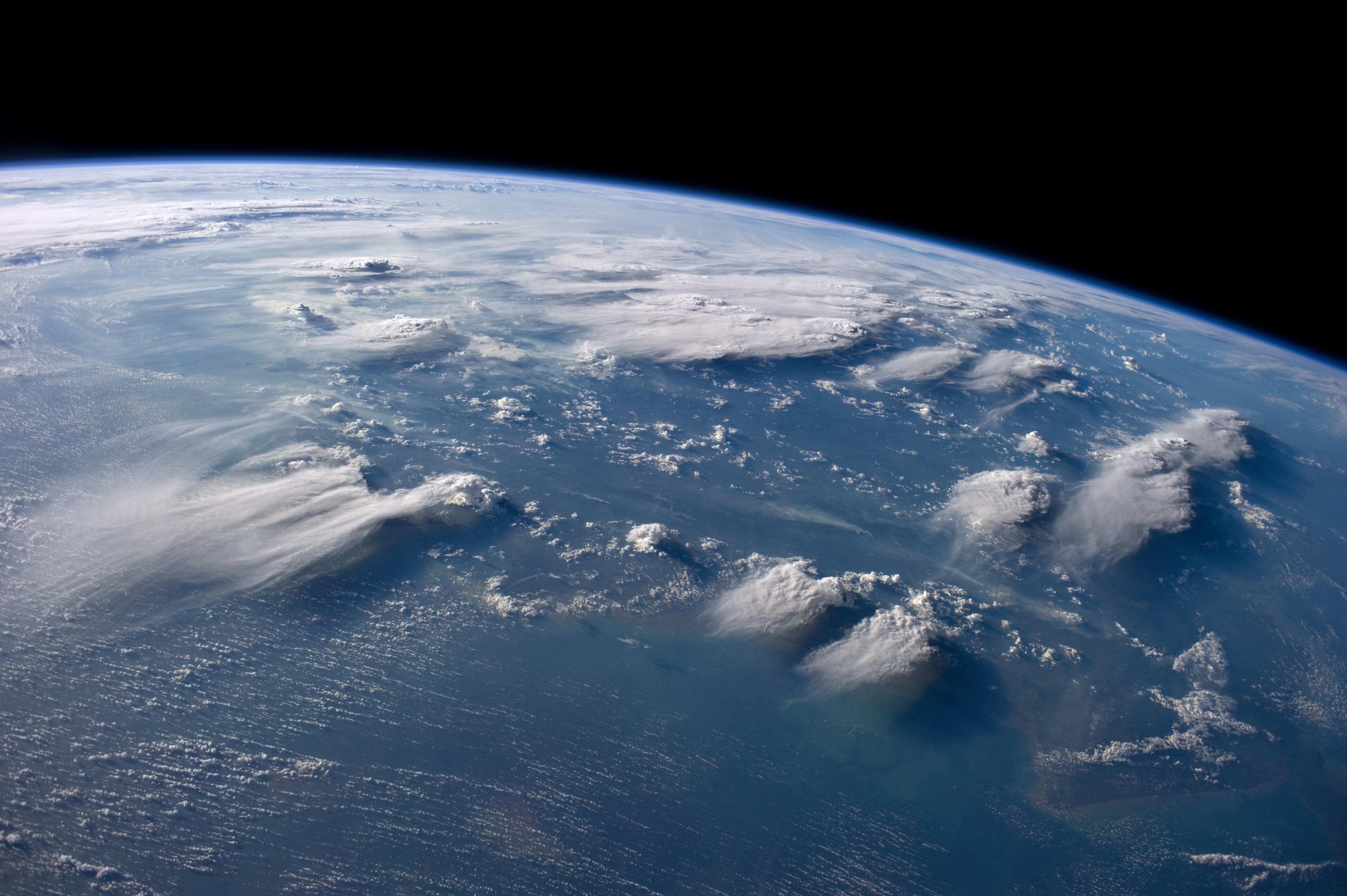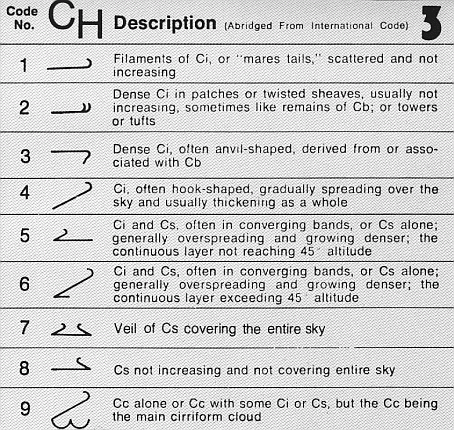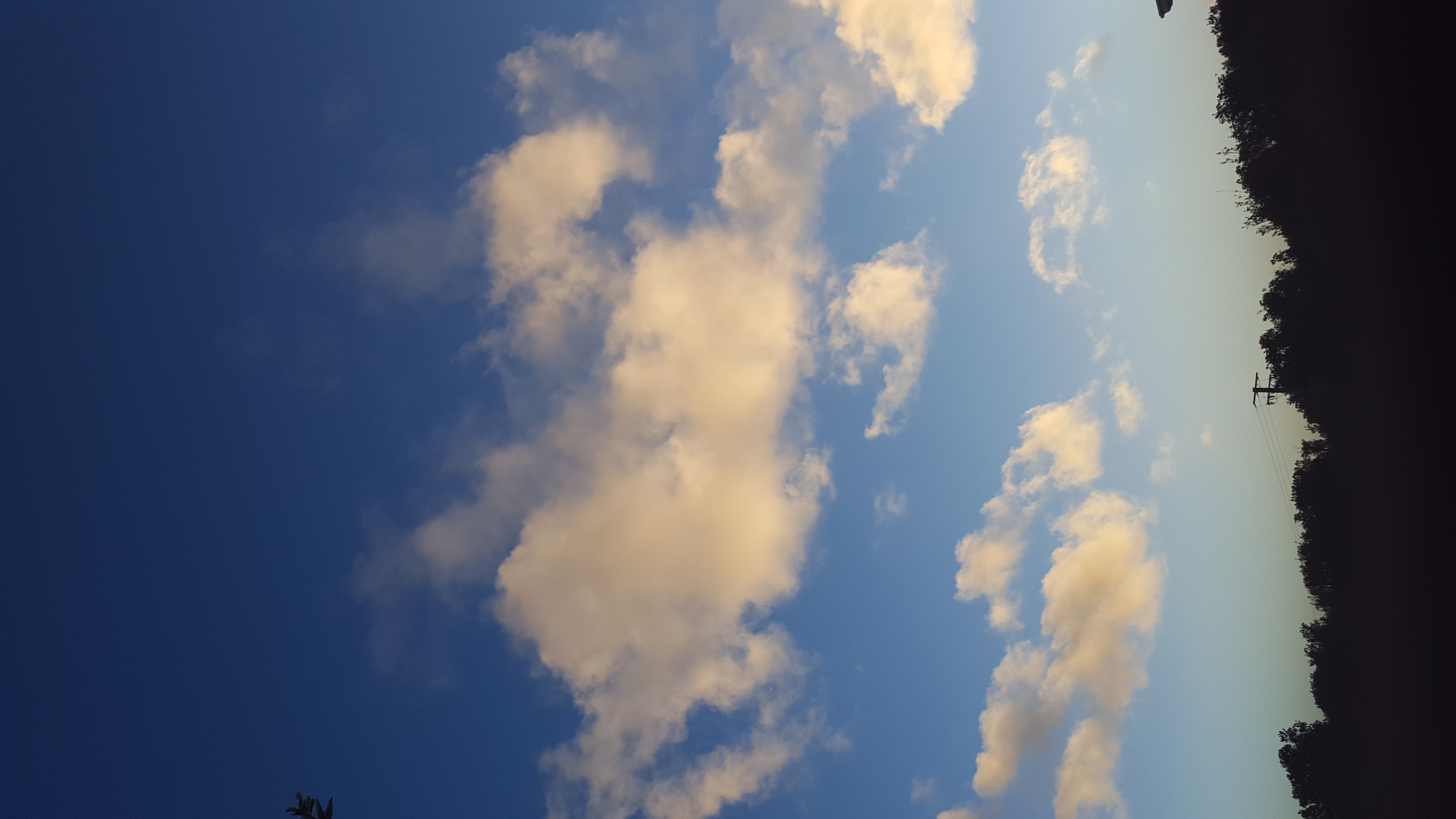|
Cumuliform
Cumulus clouds are clouds that have flat bases and are often described as puffy, cotton-like, or fluffy in appearance. Their name derives from the Latin , meaning "heap" or "pile". Cumulus clouds are low-level clouds, generally less than in altitude unless they are the more vertical cumulus congestus form. Cumulus clouds may appear by themselves, in lines, or in clusters. Cumulus clouds are often precursors of other types of clouds, such as cumulonimbus, when influenced by weather factors such as instability, humidity, and temperature gradient. Normally, cumulus clouds produce little or no precipitation, but they can grow into the precipitation-bearing cumulus congestus or cumulonimbus clouds. Cumulus clouds can be formed from water vapour, supercooled water droplets, or ice crystals, depending upon the ambient temperature. They come in many distinct subforms and generally cool the earth by reflecting the incoming solar radiation. Cumulus clouds are part of the larger cat ... [...More Info...] [...Related Items...] OR: [Wikipedia] [Google] [Baidu] |
List Of Cloud Types
The list of cloud types groups all genera as ''high'' (cirro-, cirrus), ''middle'' (alto-), ''multi-level'' (nimbo-, cumulo-, cumulus), and ''low'' (strato-, stratus). These groupings are determined by the altitude level or levels in the troposphere at which each of the various cloud types is normally found. Small Cumulus cloud, cumulus are commonly grouped with the low clouds because they do not show significant vertical extent. Of the multi-level genus-types, those with the greatest convective activity are often grouped separately as ''towering vertical''. The genus types all have Latin names. The genera are also grouped into five physical forms. These are, in approximate ascending order of instability or convective activity: ''stratiform'' sheets; ''cirriform'' wisps and patches; ''stratocumuliform'' patches, rolls, and ripples; ''cumuliform'' heaps, and ''cumulonimbiform'' towers that often have complex structures. Most genera are divided into ''species'' with Latin names, some ... [...More Info...] [...Related Items...] OR: [Wikipedia] [Google] [Baidu] |
Cloud
In meteorology, a cloud is an aerosol consisting of a visible mass of miniature liquid droplets, frozen crystals, or other particles, suspended in the atmosphere of a planetary body or similar space. Water or various other chemicals may compose the droplets and crystals. On Earth, clouds are formed as a result of saturation of the air when it is cooled to its dew point, or when it gains sufficient moisture (usually in the form of water vapor) from an adjacent source to raise the dew point to the ambient temperature. Clouds are seen in the Earth's homosphere, which includes the troposphere, stratosphere, and mesosphere. Nephology is the science of clouds, which is undertaken in the cloud physics branch of meteorology. The World Meteorological Organization uses two methods of naming clouds in their respective layers of the homosphere, Latin and common name. Genus types in the troposphere, the atmospheric layer closest to Earth's surface, have Latin names because of th ... [...More Info...] [...Related Items...] OR: [Wikipedia] [Google] [Baidu] |
Cirrocumulus
Cirrocumulus is one of the three main genus types of high-altitude tropospheric clouds, the other two being cirrus and cirrostratus. They usually occur at an altitude of , however they can occur as low as in the arctic and weather reporting standards such as the Canadian MANOBS suggests heights of in summer and in winter. Like lower-altitude cumuliform and stratocumuliform clouds, cirrocumulus signifies convection. Unlike other high-altitude tropospheric clouds like cirrus and cirrostratus, cirrocumulus includes a small amount of liquid water droplets, although these are in a supercooled Supercooling, also known as undercooling, is the process of lowering the temperature of a liquid below its freezing point without it becoming a solid. Per the established international definition, supercooling means ''‘cooling a substance be ... state. Ice crystals are the predominant component, and typically, the ice crystals cause the supercooled water drops in the cloud to rapidly ... [...More Info...] [...Related Items...] OR: [Wikipedia] [Google] [Baidu] |
Altocumulus
Altocumulus () is a middle-altitude cloud genus that belongs mainly to the physical category, characterized by globular masses or rolls in layers or patchesthe individual elements being larger and darker than those of cirrocumulus and smaller than those of stratocumulus. However, if the layers become tufted in appearance due to increased airmass instability, then the altocumulus clouds become more purely ''cumuliform'' in structure. Like other cumuliform and stratocumuliform clouds, altocumulus signifies convection. A sheet of partially conjoined altocumulus perlucidus is sometimes found preceding a weakening warm front, where the altostratus is starting to fragment, resulting in patches of altocumulus perlucidus between the areas of altostratus. Altocumulus is also commonly found between the warm and cold fronts in a depression, although this is often hidden by lower clouds. Towering altocumulus, known as altocumulus castellanus, frequently signals the development of thun ... [...More Info...] [...Related Items...] OR: [Wikipedia] [Google] [Baidu] |
Cumulus Humilis Cloud
Cumulus humilis are cumuliform clouds with little vertical extent, common in the summer, that are often referred to as "fair weather cumulus". If they develop into cumulus mediocris or cumulus congestus, thunderstorms could form later in the day. They generally form at lower altitudes (500–3000 m (1,500–10,000 ft)), but in hot countries or over mountainous terrain these clouds can occur at an altitude of up to . They show no significant vertical development, indicating that the temperature in the atmosphere above them either drops off very slowly or not at all with altitude; that is, the environmental lapse rate is small or negative. Cumulus humilis clouds often have little variance in their depths due to their constrained vertical development. Cumulus humilis may be accompanied by other cloud types. Air below the cloud base can be quite turbulent due to the thermals that formed the clouds, giving occupants of light aircraft an uncomfortable ride. To avoid turbulence ... [...More Info...] [...Related Items...] OR: [Wikipedia] [Google] [Baidu] |
Stratocumulus
A stratocumulus cloud, occasionally called a cumulostratus, belongs to a genus-type of clouds characterized by large dark, rounded masses, usually in groups, lines, or waves, the individual elements being larger than those in altocumulus, and the whole being at a lower height, usually below . Weak convective currents create shallow cloud layers (see also: sea of clouds) because of drier, stable air above preventing continued vertical development. Historically, in English, this type of cloud has been referred to as a twain cloud for being a combination of two types of clouds. Description Stratocumulus clouds are rounded clumps or patches of white to dark gray clouds that normally form in groups. The individual cloud elements, which cover more than 5 degrees of arc each, can connect with each other and are sometimes arranged in a regular pattern. Occurrence Vast areas of subtropical and polar oceans are covered with massive sheets of stratocumulus. These may organize into distinc ... [...More Info...] [...Related Items...] OR: [Wikipedia] [Google] [Baidu] |
Fractus Cloud
Fractus clouds, also called fractostratus or fractocumulus, are small, ragged cloud fragments that are usually found under an ambient cloud base. They form or have broken off from a larger cloud, and are generally sheared by strong winds, giving them a jagged, shredded appearance. Fractus have irregular patterns, appearing much like torn pieces of cotton candy. They change constantly, often forming and dissipating rapidly. They do not have clearly defined bases. Sometimes they are persistent and form very near the surface. Common kinds include and . Forms Fractus are accessory clouds, named for the type of cloud from which they were sheared. The two principal forms are cumulus fractus (formerly, fractocumulus) and stratus fractus (formerly, fractostratus). Fractus clouds may develop into cumulus if the ground heats enough to start convection. Stratus fractus is distinguishable from cumulus fractus by its smaller vertical extent, darker color, and the greater dispersion ... [...More Info...] [...Related Items...] OR: [Wikipedia] [Google] [Baidu] |
Atmospheric Convection
Atmospheric convection is the vertical transport of heat and moisture in the atmosphere. It occurs when warmer, less dense air rises, while cooler, denser air sinks. This process is driven by parcel-environment instability, meaning that a "parcel" of air is warmer and less dense than the surrounding environment at the same altitude. This difference in temperature and density (and sometimes humidity) causes the parcel to rise, a process known as buoyancy. This rising air, along with the compensating sinking air, leads to mixing, which in turn expands the height of the planetary boundary layer (PBL), the lowest part of the atmosphere directly influenced by the Earth's surface. This expansion contributes to increased winds, cumulus cloud development, and decreased surface dew points (the temperature below which condensation occurs). Convection plays a crucial role in weather patterns, influencing cloud formation, wind, and the development of thunderstorms, which can be associa ... [...More Info...] [...Related Items...] OR: [Wikipedia] [Google] [Baidu] |
Bubbles In The Sky
Bubble, Bubbles or The Bubble may refer to: Common uses * Bubble (physics), a globule of one substance in another, usually gas in a liquid ** Soap bubble * Economic bubble, a situation where asset prices are much higher than underlying fundamentals Arts, entertainment and media Fictional characters * Bubble, a character in ''Absolutely Fabulous'' * Bubble, a character in the animated series ''Adventure Time'' episode "BMO Lost" * Bubble, in the video game '' Clu Clu Land'' * Bubbles (''The Wire'') * Bubbles (''Trailer Park Boys'') * Bubbles Utonium, in ''The Powerpuff Girls'' ** Bubbles (Miyako Gotokuji), in ''Powerpuff Girls Z'' * Bubbles (''The Adventures of Little Carp'') * Bubbles the Clown, a doll used in the BBC's Test Card F * Bubbles, an oriole from the '' Angry Birds'' franchise * Bubbles, a yellow tang fish in the ''Finding Nemo'' franchise * Lourdes "Bubbles" Torres, in Philippine action drama series '' FPJ's Ang Probinsyano'' * Samantha "Bubbles" Montenegr ... [...More Info...] [...Related Items...] OR: [Wikipedia] [Google] [Baidu] |
University Of Wyoming
The University of Wyoming (UW) is a Public university, public land-grant university, land-grant research university in Laramie, Wyoming, United States. It was founded in March 1886, four years before the territory was admitted as the 44th state, and opened in September 1887. The University of Wyoming's location is written into the state's constitution. The university also offers outreach education in communities throughout Wyoming and online. The University of Wyoming consists of seven colleges: agriculture and natural resources, arts and sciences, business, education, engineering and applied sciences, health sciences, and University of Wyoming College of Law, law. The university offers over 120 undergraduate, graduate, and certificate programs including Doctor of Pharmacy and Juris Doctor. It is Carnegie Classification of Institutions of Higher Education, classified among "R1: Doctoral Universities – Very High research activity". In addition to on-campus classes in Laramie, t ... [...More Info...] [...Related Items...] OR: [Wikipedia] [Google] [Baidu] |
NASA
The National Aeronautics and Space Administration (NASA ) is an independent agencies of the United States government, independent agency of the federal government of the United States, US federal government responsible for the United States's civil list of government space agencies, space program, aeronautics research and outer space, space research. National Aeronautics and Space Act, Established in 1958, it succeeded the National Advisory Committee for Aeronautics (NACA) to give the American space development effort a distinct civilian orientation, emphasizing peaceful applications in space science. It has since led most of America's space exploration programs, including Project Mercury, Project Gemini, the 1968–1972 Apollo program missions, the Skylab space station, and the Space Shuttle. Currently, NASA supports the International Space Station (ISS) along with the Commercial Crew Program and oversees the development of the Orion (spacecraft), Orion spacecraft and the Sp ... [...More Info...] [...Related Items...] OR: [Wikipedia] [Google] [Baidu] |







